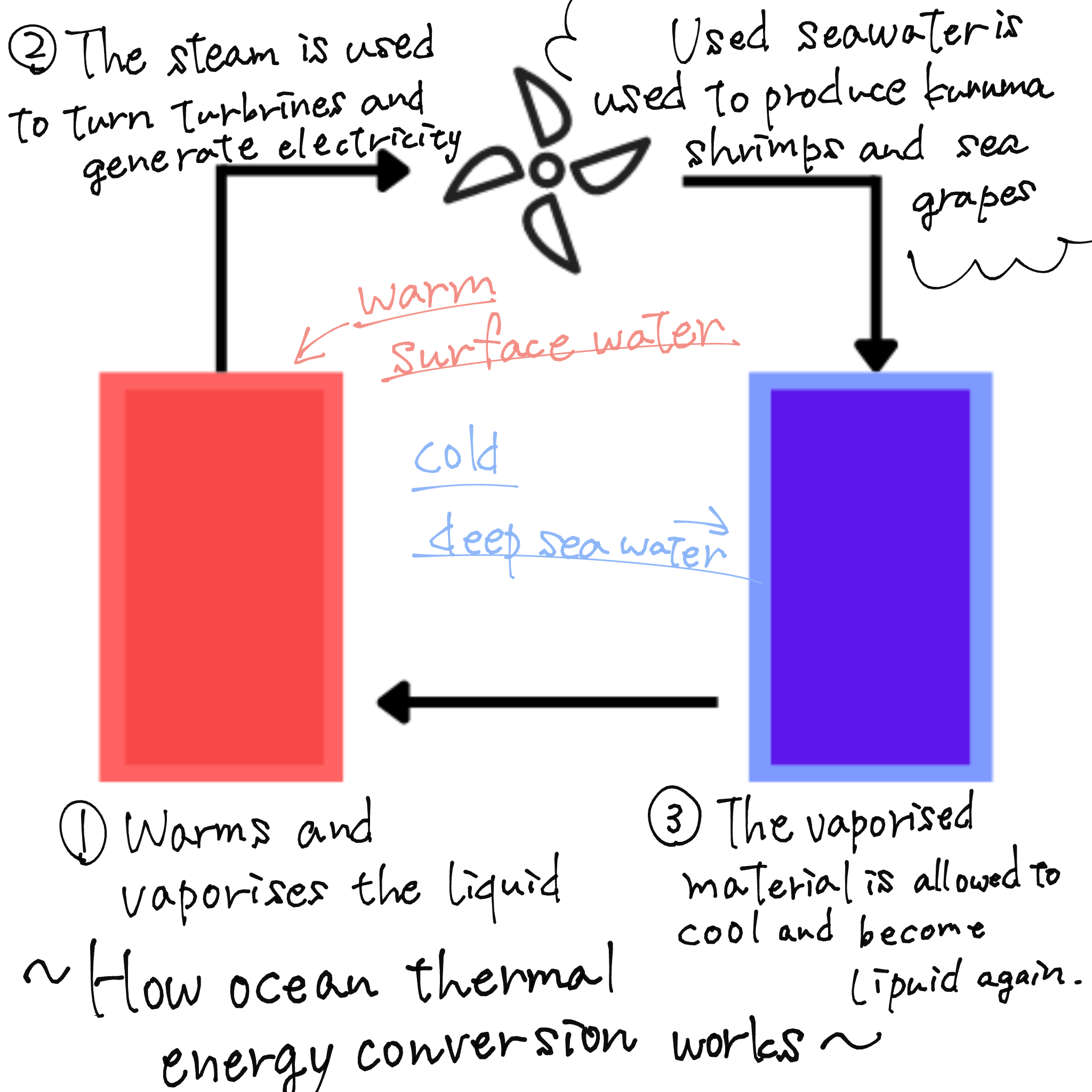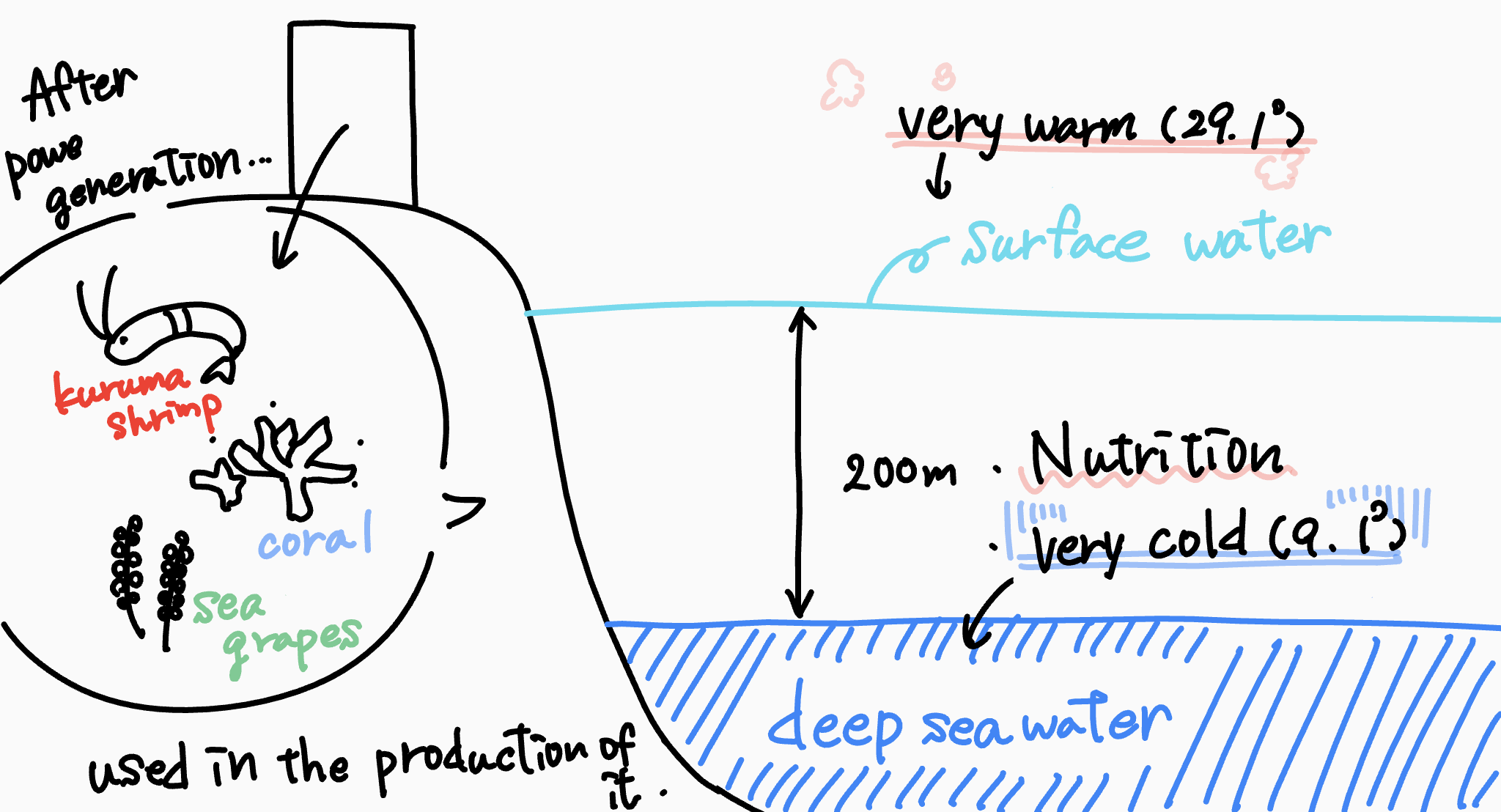<Q&A>
 |
On this page you can learn about ocean thermal energy conversion in a Q&A format! And if you'd like to learn more about ocean thermal energy conversion, be sure to check out the link, "About Ocean Thermal Energy Conversion!" |
Q. How is ocean thermal energy conversion used to generate electricity?
Ocean Thermal Energy Conversion (OTEC), as the name suggests, uses the temperature difference of ocean water to generate electricity.
As you can see in the image below, it's similar to thermal power generation, for example, where a turbine is turned to generate electricity!
The warm water at the ocean's surface is called surface water, while the water deeper in the ocean is called deep ocean water. Surface water is very warm (29.1°C) and rich in nutrients, while deep ocean water is very cold (9.1°C) and low in nutrients.
We use a liquid with a low boiling point and boil that liquid in surface water to turn a turbine. Then we boil it in deep ocean water, turn it gaseous, turn it back into liquid again, boil it again, and so on... and so on, creating an almost unlimited amount of energy!
The surface water and deep ocean water used to heat and cool liquids would later be used for coral farming, shrimp farming, sea grape production, and vegetable production!
You are the mirror of "lean power generation"!
As you can see in the image below, it's similar to thermal power generation, for example, where a turbine is turned to generate electricity!
The warm water at the ocean's surface is called surface water, while the water deeper in the ocean is called deep ocean water. Surface water is very warm (29.1°C) and rich in nutrients, while deep ocean water is very cold (9.1°C) and low in nutrients.
We use a liquid with a low boiling point and boil that liquid in surface water to turn a turbine. Then we boil it in deep ocean water, turn it gaseous, turn it back into liquid again, boil it again, and so on... and so on, creating an almost unlimited amount of energy!
The surface water and deep ocean water used to heat and cool liquids would later be used for coral farming, shrimp farming, sea grape production, and vegetable production!
You are the mirror of "lean power generation"!

Q. What is ocean thermal energy conversion?
Although it may seem like a new technology, the idea of ocean thermal energy conversion itself has actually been around since the late 19th century.
Since then, the technology has been gradually and incrementally advanced for practical use, and in 2013, a trial operation was started on Kumejima Island in Japan.
Since then, the technology has been gradually and incrementally advanced for practical use, and in 2013, a trial operation was started on Kumejima Island in Japan.
Q.What are the advantages and disadvantages of ocean thermal energy conversion?
One of the major advantages of ocean thermal energy conversion is that there is no waste.
The liquid used to generate electricity can be used semi-permanently, and as I mentioned earlier, the seawater used to heat or cool that liquid is used to produce car shrimps, sea grapes, and even for coral research!
And deep ocean water is very cold because the sun cannot reach it, so it is used for cooling inside the Ocean Thermal Energy Conversion Laboratory.
But the greatest strength of deep seawater is its ability to generate electricity stably and uninterruptedly 24 hours a day, 365 days a year!
With energy shortages currently being a concern for a variety of reasons, I believe that ocean thermal energy conversion, which can generate power in a stable manner, will continue to attract attention.
The liquid used to generate electricity can be used semi-permanently, and as I mentioned earlier, the seawater used to heat or cool that liquid is used to produce car shrimps, sea grapes, and even for coral research!
And deep ocean water is very cold because the sun cannot reach it, so it is used for cooling inside the Ocean Thermal Energy Conversion Laboratory.
But the greatest strength of deep seawater is its ability to generate electricity stably and uninterruptedly 24 hours a day, 365 days a year!
With energy shortages currently being a concern for a variety of reasons, I believe that ocean thermal energy conversion, which can generate power in a stable manner, will continue to attract attention.
However, ocean thermal energy conversion is not all merits.
One major disadvantage is that the areas where power can be generated are limited.
Since ocean thermal energy conversion uses the temperature difference of seawater to generate electricity, seawater must be available, and the temperature difference between the surface and deep water must be at least 15 degrees Celsius.
And it costs a lot of money to install the machine, and the power generation efficiency is not very good for that.... Therefore, in many areas, it has not yet been put to practical use.
One major disadvantage is that the areas where power can be generated are limited.
Since ocean thermal energy conversion uses the temperature difference of seawater to generate electricity, seawater must be available, and the temperature difference between the surface and deep water must be at least 15 degrees Celsius.
And it costs a lot of money to install the machine, and the power generation efficiency is not very good for that.... Therefore, in many areas, it has not yet been put to practical use.
Q.What is surface water and deep sea water?
Surface water is the warm water near the sea surface.
As of October 1, the temperature is 29.1 degrees Celsius, indicating that it is very warm. The surface water used for ocean thermal energy conversion is then used mainly for the production of sea grapes and coral cultivation. The production of sea grapes requires seawater that is moderately nutritious and not too warm. Since surface water does not contain many nutrients, the places that produce umi budou use both surface water and deep seawater, adjusting the temperature to be just right for each season.
Deep seawater is water that is deeper than 200 meters below the surface where the sun does not reach.
As of October 1, the temperature is 9.1 degrees Celsius, which is very cold. Although the sun's rays do not reach it, the water is rich in nutrients for marine life, clean, low temperature, and rich in minerals. Deep seawater is so cold that it is applied and used for cooling inside the Ocean Thermal Energy Conversion Laboratory. Deep seawater used for ocean thermal energy conversion is then used for the production of sea grapes and coral cultivation in the same way as surface water. Deep seawater, which contains a lot of nutrients, is not good for organisms such as corals that cannot grow with too much nutrients, so it is mixed with surface water.
As of October 1, the temperature is 29.1 degrees Celsius, indicating that it is very warm. The surface water used for ocean thermal energy conversion is then used mainly for the production of sea grapes and coral cultivation. The production of sea grapes requires seawater that is moderately nutritious and not too warm. Since surface water does not contain many nutrients, the places that produce umi budou use both surface water and deep seawater, adjusting the temperature to be just right for each season.
Deep seawater is water that is deeper than 200 meters below the surface where the sun does not reach.
As of October 1, the temperature is 9.1 degrees Celsius, which is very cold. Although the sun's rays do not reach it, the water is rich in nutrients for marine life, clean, low temperature, and rich in minerals. Deep seawater is so cold that it is applied and used for cooling inside the Ocean Thermal Energy Conversion Laboratory. Deep seawater used for ocean thermal energy conversion is then used for the production of sea grapes and coral cultivation in the same way as surface water. Deep seawater, which contains a lot of nutrients, is not good for organisms such as corals that cannot grow with too much nutrients, so it is mixed with surface water.




